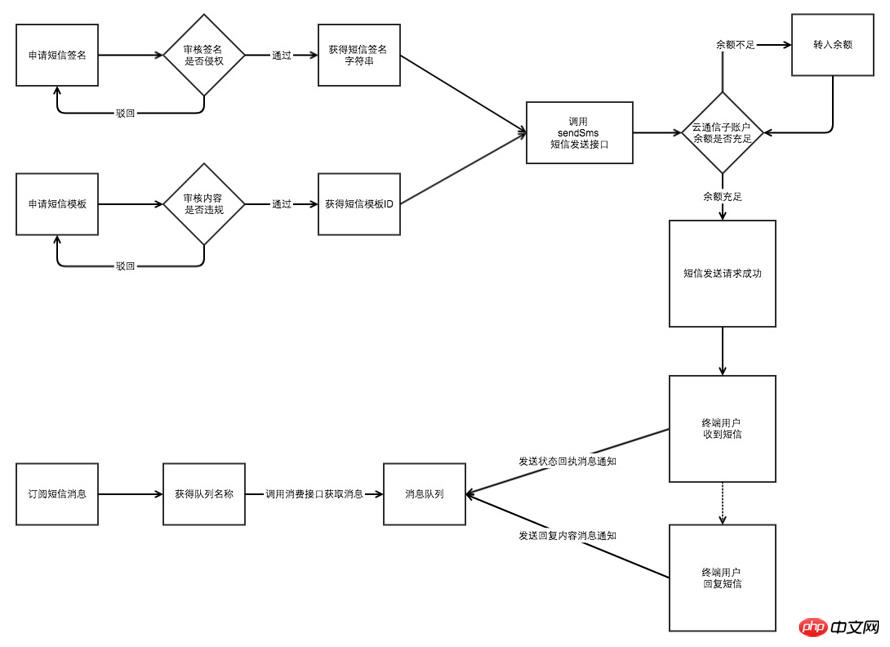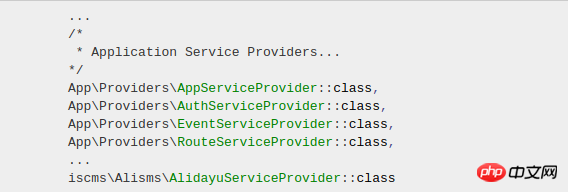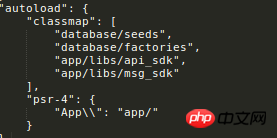 Backend Development
Backend Development
 PHP Tutorial
PHP Tutorial
 PHP example of implementation method of sending verification code via SMS in laravel
PHP example of implementation method of sending verification code via SMS in laravel
PHP example of implementation method of sending verification code via SMS in laravel
When doing user registration and personal center security management, it is often necessary to use SMS to send verification codes. The following article mainly introduces you to the implementation method of sending verification codes through SMS in laravel. The article introduces it through sample code. For details, friends who need it can refer to it. Let’s learn with the editor below.
Preface
Some time ago I wanted to implement a SMS verification code function, but it was stuck for a long time.
First of all, I used Alibaba Cloud’s SMS service. The first access process is as follows:

Open SMS service on Alibaba Cloud What you need to do next:
1. Apply for signature 2. Apply for template 3. Create Accesskey. It is worth mentioning that you can create Accesskey through the sub-user provided by Alibaba Cloud, which can be more secure 4 , Recharge
laravel has many extension packages for SMS services. I used Alibaba before. Use the following:
1. Enter your project from the terminal or command, run: composer require iscms/alisms-for-laravel
2, add: iscms\Alisms\AlidayuServiceProvider::class to the Providers of config\app.php, similar to:

3. Run: php artisan vendor:publish. This will add an alisms.php file under the config folder with the following content:
<?php return [ 'KEY' =>env('ALISMS_KEY',null), 'SECRETKEY'=>env('ALISMS_SECRETKEY',null), ];
4. Write in the .env file:
ALISMS_KEY=23305789 ALISMS_SECRETKEY=**************
Note: ALISMS_KEY and ALISMS_SECRETKEY are the access key pairs generated by Alibaba Cloud (AccessKeyId and AccessKeySecret)
Get started:
1 , introduce SMS in the controller where you need to call the SMS service:
Use iscms\Alisms\SendsmsPusher as Sms;
public function __construct(Sms $sms)
{
$this->sms=$sms;
}
public function index()
{
$result=$this->sms->send("$phone","$name","$content","$code");
}- $phone refers to the SMS number of the party receiving the SMS,
- $name refers to the SMS signature and can be found at Alibaba Dayu SMS Signature http://www.alidayu.com/admin/service/sign
- $content refers to the SMS Variable content in the template. For example
{
code:"生成的验证码",
product:"示例项目"
}
composer dumpautoload
<?php
// namespace App\Http\Controllers\sms;
use Aliyun\Core\Config;
use Aliyun\Core\Profile\DefaultProfile;
use Aliyun\Core\DefaultAcsClient;
use Aliyun\Api\Sms\Request\V20170525\SendSmsRequest;
use Aliyun\Api\Sms\Request\V20170525\QuerySendDetailsRequest;
use App\Http\Controllers\Controller;
// 加载区域结点配置
Config::load();
class SmsController extends Controller
{
/**
* 构造器
* @param string $accessKeyId 必填,AccessKeyId
* @param string $accessKeySecret 必填,AccessKeySecret
*/
public function __construct($accessKeyId="######",$accessKeySecret="#######")
{
// 短信API产品名
$product = "Dysmsapi";
// 短信API产品域名
$domain = "dysmsapi.aliyuncs.com";
// 暂时不支持多Region
$region = "cn-hangzhou";
// 服务结点
$endPointName = "cn-hangzhou";
// 初始化用户Profile实例
$profile = DefaultProfile::getProfile($region, $accessKeyId, $accessKeySecret);
// 增加服务结点
DefaultProfile::addEndpoint($endPointName, $region, $product, $domain);
// 初始化AcsClient用于发起请求
$this->acsClient = new DefaultAcsClient($profile);
}
/**
* 发送短信范例
* @param [type] $phoneNumbers 必填, 短信接收号码
* @param string $signName 必填, 短信签名,应严格"签名名称"填写,
* @param string $templateCode 必填, 短信模板Code,应严格按"模板CODE"填写,
* @param [type] $outId 选填, 假如模板中存在变量需要替换则为必填项
* @return [type] [description]
*/
public function sendSms($phoneNumbers,$signName="XX软件",$templateCode="SMS_XXXXXX",$outId=null)
{
// 初始化SendSmsRequest实例用于设置发送短信的参数
$request = new SendSmsRequest;
// 必填,设置雉短信接收号码
$request->setPhoneNumbers($phoneNumbers);
// 必填,设置签名名称
$request->setSignName($signName);
// 必填,设置模板CODE
$request->setTemplateCode($templateCode);
$num = rand(100000,999999);
// 可选,设置模板参数
$request->setTemplateParam(json_encode(
Array(
"code" => "$num"
)
));
// 可选,设置流水号
if($outId) {
$request->setOutId($outId);
}
// 发起访问请求
$acsResponse = $this->acsClient->getAcsResponse($request);
}
/**
* 查询短信发送情况范例
* @param [type] $phoneNumbers 必填, 短信接收号码
* @param [type] $sendDate 必填,短信发送日期,格式Ymd,支持近30天记录查询
* @param integer $pageSize 必填,分页大小
* @param integer $currentPage 必填,当前页码
* @param [type] $bizId 选填,短信发送流水号
* @return [type] [description]
*/
public function queryDetails($phoneNumbers,$sendDate,$pageSize=10,$currentPage=1,$bizId=null)
{
// 初始化QuerySendDetailsRequest实例用于设置短信查询的参数
$request = new QuerySendDetailsRequest();
$request->setPhoneNumber($phoneNumbers);
$request->setSendDate($sendDate);
$request->setPageSize($pageSize);
$request->setCurrentPage($currentPage);
if($bizId) {
$request->setBizId($bizId);
}
$acsResponse = $this->acsClient->getAcsResponse($request);
}
}Summary
Articles you may be interested in:PHP receiveMail implementation Email receiving function php example
PHP sharing image generation method php skills
laravel 5.4 vue vux element environment PHP example of the matching process
The above is the detailed content of PHP example of implementation method of sending verification code via SMS in laravel. For more information, please follow other related articles on the PHP Chinese website!

Hot AI Tools

Undresser.AI Undress
AI-powered app for creating realistic nude photos

AI Clothes Remover
Online AI tool for removing clothes from photos.

Undress AI Tool
Undress images for free

Clothoff.io
AI clothes remover

Video Face Swap
Swap faces in any video effortlessly with our completely free AI face swap tool!

Hot Article

Hot Tools

Notepad++7.3.1
Easy-to-use and free code editor

SublimeText3 Chinese version
Chinese version, very easy to use

Zend Studio 13.0.1
Powerful PHP integrated development environment

Dreamweaver CS6
Visual web development tools

SublimeText3 Mac version
God-level code editing software (SublimeText3)

Hot Topics
 1663
1663
 14
14
 1420
1420
 52
52
 1315
1315
 25
25
 1266
1266
 29
29
 1239
1239
 24
24
 Laravel Introduction Example
Apr 18, 2025 pm 12:45 PM
Laravel Introduction Example
Apr 18, 2025 pm 12:45 PM
Laravel is a PHP framework for easy building of web applications. It provides a range of powerful features including: Installation: Install the Laravel CLI globally with Composer and create applications in the project directory. Routing: Define the relationship between the URL and the handler in routes/web.php. View: Create a view in resources/views to render the application's interface. Database Integration: Provides out-of-the-box integration with databases such as MySQL and uses migration to create and modify tables. Model and Controller: The model represents the database entity and the controller processes HTTP requests.
 Solve caching issues in Craft CMS: Using wiejeben/craft-laravel-mix plug-in
Apr 18, 2025 am 09:24 AM
Solve caching issues in Craft CMS: Using wiejeben/craft-laravel-mix plug-in
Apr 18, 2025 am 09:24 AM
When developing websites using CraftCMS, you often encounter resource file caching problems, especially when you frequently update CSS and JavaScript files, old versions of files may still be cached by the browser, causing users to not see the latest changes in time. This problem not only affects the user experience, but also increases the difficulty of development and debugging. Recently, I encountered similar troubles in my project, and after some exploration, I found the plugin wiejeben/craft-laravel-mix, which perfectly solved my caching problem.
 Laravel user login function
Apr 18, 2025 pm 12:48 PM
Laravel user login function
Apr 18, 2025 pm 12:48 PM
Laravel provides a comprehensive Auth framework for implementing user login functions, including: Defining user models (Eloquent model), creating login forms (Blade template engine), writing login controllers (inheriting Auth\LoginController), verifying login requests (Auth::attempt) Redirecting after login is successful (redirect) considering security factors: hash passwords, anti-CSRF protection, rate limiting and security headers. In addition, the Auth framework also provides functions such as resetting passwords, registering and verifying emails. For details, please refer to the Laravel documentation: https://laravel.com/doc
 Laravel and the Backend: Powering Web Application Logic
Apr 11, 2025 am 11:29 AM
Laravel and the Backend: Powering Web Application Logic
Apr 11, 2025 am 11:29 AM
How does Laravel play a role in backend logic? It simplifies and enhances backend development through routing systems, EloquentORM, authentication and authorization, event and listeners, and performance optimization. 1. The routing system allows the definition of URL structure and request processing logic. 2.EloquentORM simplifies database interaction. 3. The authentication and authorization system is convenient for user management. 4. The event and listener implement loosely coupled code structure. 5. Performance optimization improves application efficiency through caching and queueing.
 Laravel framework installation method
Apr 18, 2025 pm 12:54 PM
Laravel framework installation method
Apr 18, 2025 pm 12:54 PM
Article summary: This article provides detailed step-by-step instructions to guide readers on how to easily install the Laravel framework. Laravel is a powerful PHP framework that speeds up the development process of web applications. This tutorial covers the installation process from system requirements to configuring databases and setting up routing. By following these steps, readers can quickly and efficiently lay a solid foundation for their Laravel project.
 How to learn Laravel How to learn Laravel for free
Apr 18, 2025 pm 12:51 PM
How to learn Laravel How to learn Laravel for free
Apr 18, 2025 pm 12:51 PM
Want to learn the Laravel framework, but suffer from no resources or economic pressure? This article provides you with free learning of Laravel, teaching you how to use resources such as online platforms, documents and community forums to lay a solid foundation for your PHP development journey from getting started to master.
 How to view the version number of laravel? How to view the version number of laravel
Apr 18, 2025 pm 01:00 PM
How to view the version number of laravel? How to view the version number of laravel
Apr 18, 2025 pm 01:00 PM
The Laravel framework has built-in methods to easily view its version number to meet the different needs of developers. This article will explore these methods, including using the Composer command line tool, accessing .env files, or obtaining version information through PHP code. These methods are essential for maintaining and managing versioning of Laravel applications.
 What versions of laravel are there? How to choose the version of laravel for beginners
Apr 18, 2025 pm 01:03 PM
What versions of laravel are there? How to choose the version of laravel for beginners
Apr 18, 2025 pm 01:03 PM
In the Laravel framework version selection guide for beginners, this article dives into the version differences of Laravel, designed to assist beginners in making informed choices among many versions. We will focus on the key features of each release, compare their pros and cons, and provide useful advice to help beginners choose the most suitable version of Laravel based on their skill level and project requirements. For beginners, choosing a suitable version of Laravel is crucial because it can significantly impact their learning curve and overall development experience.



